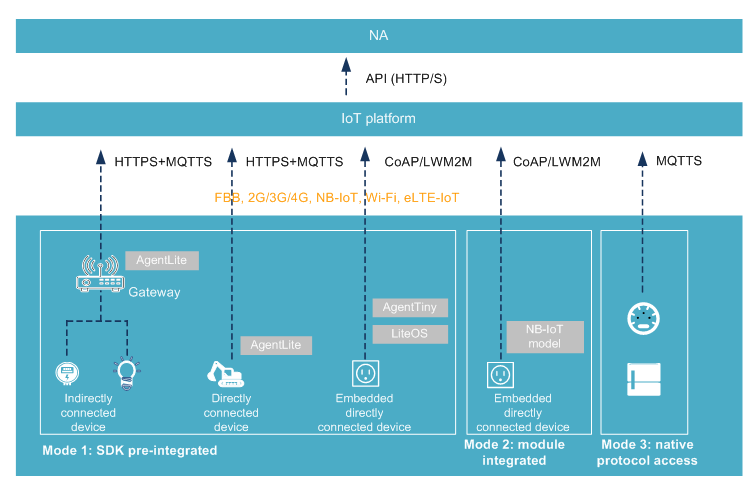Device Access
Devices can connect to the IoT platform directly or through gateways. They can also access the IoT platform using a variety of protocols and different Agents through multiple types of networks. Protocols are parsed on the cloud for fast device access.
- Multi-Agent access: Agents such as AgentLite and AgentTiny, and languages including C, Java, and Python are supported. Agents are pre-integrated with chipsets and modules of mainstream brands such as HiSilicon and Qualcomm to shorten the TTM.
- Multi-protocol access: Access using HTTPS+MQTTS, MQTTS, and LWM2M/CoAP is supported.
- Multi-network access: Wired and wireless access, such as fixed broadband (FBB), 2G/3G/4G/5G, NB-IoT, Z-Wave, Zigbee, and eLTE-IoT are supported.

Method 1: agent pre-integrated
- Indirectly connected device: The Huawei AgentLite SDK is integrated on a gateway, and devices that do not have the IP capability are connected to the IoT platform through the gateway. This method applies to industrial IoT and smart campus scenarios.
- Directly connected device: Computing and storage devices that have IP capabilities are directly integrated with the Huawei AgentLite SDK and can connect to the IoT platform over HTTPS+MQTTS.
- Embedded, directly connected device: Lightweight embedded devices such as sensors, meters, and controllers are integrated with the Huawei AgentTiny SDK (which can be used together with LiteOS) and can connect to the IoT platform over CoAP/LWM2M. This method applies to scenarios that require low power consumption and low real-time performance, such as smart metering.
Mode 2: module integrated
Lightweight embedded devices such as sensors, meters, and controllers are integrated with Huawei certified communication modules and can connect to the IoT platform over CoAP/LWM2M. This method applies to scenarios that require low power consumption and low real-time performance, such as smart metering.
Method 3: native protocol access
Devices can connect to the IoT platform over the native MQTTS protocol. This applies to persistent connection scenarios, such as smart street lamps.
Feedback
Was this page helpful?
Provide feedbackThank you very much for your feedback. We will continue working to improve the documentation.See the reply and handling status in My Cloud VOC.
For any further questions, feel free to contact us through the chatbot.
Chatbot





